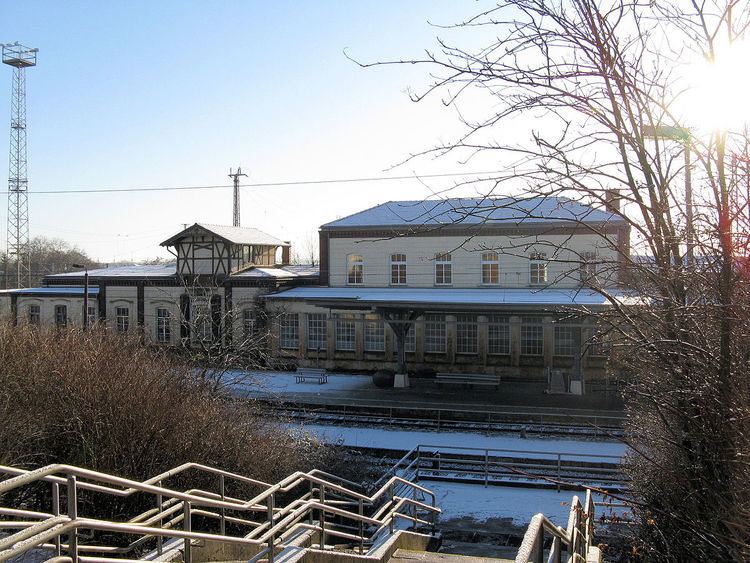Station code 289 IBNR 8010018 Opened 1848 | DS100 code WK Category 3 Platforms in use 5 | |
 | ||
Line(s) Schwerin–Bad Kleinen–Wismar (KBS 204, KBS 100)Bad Kleinen–Rostock (KBS 100,KBS 175)Bad Kleinen–Lübeck (KBS 175) Address 23996 Bad Kleinen, Germany Similar Bützow station, Schwerin Hauptbahnhof, Wismar station, Blankenberg (Meckl) station, Lübeck Hauptbahnhof | ||
Bad Kleinen station is in the community of Bad Kleinen and is one of the oldest and most important railway stations in the German state of Mecklenburg-Vorpommern. It primarily operates as a transfer station for traffic to and from Wismar, Grevesmühlen / Lübeck, Schwerin and Bützow / Güstrow / Rostock.
Contents
History
The town of Kleinen (the prefix "Bad", meaning “Spa town”, was awarded in 1915) was connected to the rail network in 1848, one year after the opening of the Hagenow Land–Schwerin railway, with the extension to Wismar. In planning the extension of the line from Schwerin to Rostock it was subsequently decided not to build the line directly from Schwerin, which would have required a crossing of Lake Schwerin. As a result, Kleinen became, after Hagenow Land, the second railway hub of Mecklenburg. In 1870, a line to Lübeck was opened via Grevesmühlen.
The station was rebuilt around 1920. Before that the “home” platforms were located next to the entrance building and other platforms were reached by crossing the tracks. During the rebuilding, island platforms were built on either side of the station building, which are reached by a tunnel.
In the first half of the 20th century, the most important routes through the station were the east-west route, Hamburg–Lübeck–Bad Kleinen–Bützow and continuing to Stettin (now Szczecin) and the route to the ferries in Warnemünde and Sassnitz. After the Second World War and the division of Germany passenger and freight traffic from the south of East Germany via Magdeburg–Wittenberg to Rostock and Wismar became particularly important for the station.
On 3 April 1975, the 300th relay interlocking in East Germany was put into operation in the station. It replaced several mechanical interlockings. In 1985, the railway station and the lines to Bützow–Rostock, Wismar and Schwerin–Magdeburg were electrified. On 12 April 1986, a celebration was held at the station for the 1000th km of line electrified since 1981 as part of the Free German Youth's “Youth Project" (Jugendobjekt). The memorial plaque was a victim of the changes that occurred in the early 1990s. The electrification of the Magdeburg region mainly served the export of potash through the port of Wismar.
The station is famous for the occasion in 1993 when the police tried to arrest Red Army Faction members Birgit Hogefeld and Wolfgang Grams. Grams and GSG-9 officer Michael Newrzella were shot and killed in a shootout on one of the platforms.
Since the timetable change in December 2008, nearly all intercity trains no longer stop at Bad Kleinen. Until that time, most long distance trains running on the line through the station had stopped at it.
Infrastructure
The station is an “island” station, situated between tracks. The station building is located between the two island platforms served by tracks 1/2 (especially serving traffic towards Wismar and Rostock) and 3/4. Platform track 5 is reached from platform 4. Tracks 3, 4 and 5 are used primarily for services towards Schwerin and Lübeck.
The station is located on a hillside between the town and Lake Schwerin. This has resulted in a structural feature: in the mid-1980s a footbridge was built to the station over the tracks from the forecourt to reach the first floor of the entrance building and there is a staircase inside the building to the ground floor.
There are no platforms next to the entrance building, all platforms are only accessible through a platform tunnel. There is no direct exit towards Lake Schwerin. The Eiertunnel (“egg tunnel”), which is located to the west of the station, gives pedestrian access to the lake.
The ticket office and the restaurant in the station building were closed in the 1990s and it is now only used for administration.
The entrance building and most buildings and structures at the station date back to the 19th century. This includes a building built in 1880, which contains a water tower and a roundhouse. The external platforms are virtually unchanged since the reconstruction in 1920.
On 21 March 2011, extensive renovations began at the station. Completion is planned for 2015. The platforms, track and signalling system are to be replaced. After completion of the work trains will be able to run through the station at 100 km/h.
Train services
The station is served by the following services:
Every two hours Regional-Express services on the Wismar–Berlin, Rostock–Hamburg, and Bad Kleinen–Lübeck routes in both directions stop in the station simultaneously and connections can be made in all directions.
